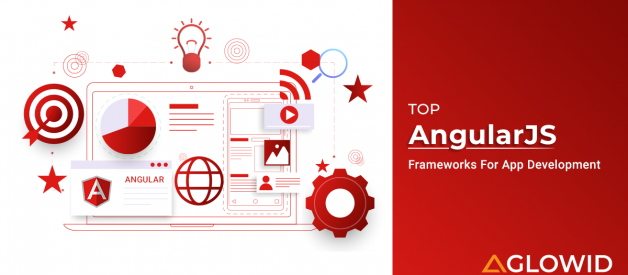For achieving success, you should choose the right framework wisely for your app development. If other organizations or companies are using a current framework that doesn?t mean you should start adopting it. It won?t work well for your projects if you keep depending on the policies and the setup what other organizations are adopting. Besides, frameworks are selected on the basis of the project?s requirement.
AngularJS Frameworks are usually known for their versatility. The first introduction of AngularJS was performed in 2012 by Google. It offered tremendous support to the Angular framework. Angular is an open-source JavaScript framework which is used for building Single Page Applications in website and smartphones. It brought revolutionary changes in the web development field, and the developer community warmly welcomed it.
 Top AngularJS Frameworks For App Development
Top AngularJS Frameworks For App Development
In today?s era, developers of Angular are known with the elements of the Angular framework and its management for creating marvelous web and mobile apps. To help you in building more advanced applications we have created a list highlighting some best AngularJS frameworks:
1. Angular UI Bootstrap:
It is built on one of the most popular front-end frameworks, i.e. Bootstrap. Bootstrap is an open source front-end web framework consisting of HTML and CSS-based design templates. Angular UI Bootstrap also consists of components of the BootStrap like Carousel, Collapse, and Alert.
All the above components are shifted to HTML and AngularJS directives(ng-controller & ng-repeat). For Example, instead of using <div> for wraping up the carousel, you can adopt ?meaningful? custom element, <carousel> & <slide>:
<carousel interval=?slideInterval?>
<slide ng-repeat=?slide in slides? active=?slide.active?>
<img ng-src=?{{slide.image}}?>
</slide>
</carousel>
Pros:
? It includes a large community in offering instant and wide support.
? It is not compulsory to adopt JQuery.
? Stable Angular framework
Cons:
? Consistent efforts required in adding custom functionalities.
? Difficult in customization.
2. Lumx:
The front-end framework is designed on the basis of Google Material Design. Lumix guides the developer in creating gorgeous applications and material designs. Based on Google guidelines, it becomes a very simple and fast process to build applications with the help of Lumx. However, Lumx also rolled out an official statement ? ? Just a little bit of JQuery.? And because of this many developers showed their disinterest in this by describing there are many other frameworks in the market which doesn?t require Query.
Lumx is also helpful for customizing the design of application with SAAS, Neat, Bourbon etc and will also improve the app functionality.
Pros:
? Improves the functionality by automatically optimizing your files.
? All the necessary measures and specifications of Google Material design documents are followed by Lumx framework.
? One of the best choice in building customized design for applications.
Cons:
? Some part of the documentation is poorly described.
? Being in a production ready-state, it can?t be verified.
3. Ionic:
Ionic is an open-source SDK which is used for creating hybrid applications. The main benefit of using a hybrid model is that it saves your time and later you can use that code again for developing applications. However, a hybrid model isn?t the best solution for the entire problem, but it?s a good choice for deploying your app quicker and building prototype apps.
With strong and sturdy building blocks, Ionic app development is simple and faster. Each and every component in the Ionic framework is optimized for the mobile experience which is essentially relied on gestures and touch. While creating tabbed navigation, you can use <ion-tabs>:
<ion-tabs class=?tabs-default tabs-icon-only?>
<ion-tab title=?Home? icon-on=?ion-ios-home? icon-off=?ion-ios-home-outline?>
</ion-tab>
<!– The rest of the tabs go here –>
</ion-tabs>
Pros:
? It can easily be optimized for iOS and Android devices.
? It is wrapped around AngularJS which offers faster performance.
? You can also get access to CLI tool with the Ionic framework.
Cons:
? The default UI of Ionic is dull.
? The animation section may lag behind in low-end mobile devices.
4. Mobile Angular UI:
It is an extension of a Bootstrap framework which is targeted for building advanced mobile apps. Most of the mobile app developers choose this framework for designing mobile apps powered by HTML5. Most of the syntaxes are from the Bootstrap 3 with some extra added mobile-specific components like switches, sidebars etc.
You can import your current application into the mobile version by including some of the provided CSS for changing your content into a responsive one and touch-enabled.
Pros:
? Lightweight and fast
? It contains syntaxes of mobile bootstrap 3
? Conversion of an app from desktop to mobile is simple.
Cons:
? Though being in the market for a good time, the community is still not existent.
? Compared with other frameworks, the documentation is below average.
5. OnsenUI:
Though OnsenUI is less popular than Ionic, OnsenUI stands out as a fierce competitor against Ionic. Both Ionic and OnsenUI were launched in the same year. Unlike Ionic, OnsenUI can be used for both mobile app as well as web application development. Prior to that, OnsenUI provides a top-quality speed in terms of app development. As per our expert developers for app development, we suggest you choose Angular Bootstrap instead of OnsenUI.
Pros:
? Contains effective tools like Monaca IDE.
? Supports AngularJS and jQuery
? It can be adopted for both Web and Mobile app development
Cons:
? Compared to other frameworks, UI of OnsenUI is boring.
? Support can be offered only through means of StackOverflow.
6. Angular Foundation:
Foundation is a framework which has been ported to adopt AngularJS is quietly named as Angular Foundation. Angular Foundation has brought some changes into components of Foundation to endorse AngularJS directives and custom elements of HTML; So that you can develop your web app using more semantically named HTML elements like <top-bar>, <pagination>, and <accordion> instead of using <div>. Example of adding Alert component with <alert> element:
<div ng-controller=?alertArea?>
<alert ng-repeat=?alert in alerts? type=?alert.type? close=?closeAlert($index)?>{{alert.msg}}</alert>
</div>
If you think ?foundation? is better than ?bootstrap? than you?re correct as it is merely an update of the Foundation framework. Some of the features which are available to the user in terms of semantic HTML components are a trigger, popover, process bar.
Pros:
? The process of conversion is very effective and next to perfect
? No requirements for jQuery support.
Cons:
? Follows traditional one-page documentation
? Community size is very small.
If you?re an Angular Developer, there are numerous choices for you to choose one of the best AngularJS framework for app development. But you should keep in mind that you should select the one which fits best for your project?s requirement like components, features etc .


